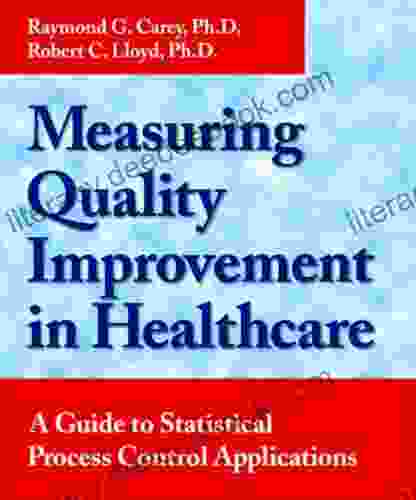Measuring Quality Improvement in Healthcare: Ensuring Effective and Patient-Centered Care

:
In the dynamic and ever-evolving healthcare landscape, quality improvement (QI) initiatives hold paramount importance. Measuring QI enables healthcare organizations to evaluate the efficacy of their efforts, track progress, and ensure the delivery of high-quality patient care. This article explores the significance of measuring QI, discusses key metrics and methodologies, and highlights the challenges and benefits associated with this essential process.
The Importance of Measuring QI
Measuring QI provides invaluable insights into the effectiveness and impact of healthcare interventions. It helps identify areas for improvement, promotes accountability, and facilitates evidence-based decision-making. By tracking and analyzing performance data, healthcare providers can:
4.3 out of 5
| Language | : | Japanese |
| File size | : | 7356 KB |
| Text-to-Speech | : | Enabled |
| Enhanced typesetting | : | Enabled |
| Print length | : | 31 pages |
| Lending | : | Enabled |
- Identify gaps and opportunities: QI measures reveal potential areas for improvement, allowing organizations to target interventions and optimize care delivery.
- Monitor progress: Regular measurement allows organizations to track the progress of QI initiatives and assess their effectiveness over time.
- Ensure patient-centered care: QI metrics focus on patient satisfaction, safety, and outcomes, ensuring that healthcare services are tailored to patient needs.
- Enhance accountability: Measuring QI fosters accountability among healthcare providers, encouraging them to strive for continuous improvement.
Key Metrics and Methodologies for Measuring QI
Numerous metrics and methodologies are available for measuring QI. The selection of appropriate measures depends on the specific context and objectives of the QI initiative. Commonly used metrics include:
- Process metrics: These measure the adherence to established standards or procedures, such as hand hygiene compliance or patient wait times.
- Outcome metrics: These measure the direct impact of healthcare interventions on patient health, such as mortality rates, infection rates, or pain reduction.
- Patient experience metrics: These assess patient satisfaction, such as patient ratings of care, patient surveys, and complaints.
Methodologies for Measuring QI:
Several methodologies can be used to measure QI, including:
- Data collection and analysis: Involves gathering and analyzing data from various sources, such as patient records, surveys, and administrative data.
- Statistical analysis: Uses statistical techniques to identify trends, patterns, and correlations within QI data.
- Process mapping: Helps visualize healthcare processes and identify areas for improvement.
- Plan-Do-Study-Act (PDSA) cycles: A structured approach for testing and refining QI interventions.
Challenges and Benefits of Measuring QI
Challenges:
Despite its importance, measuring QI can present certain challenges:
- Data availability and accuracy: Ensuring the availability and reliability of data for QI measurement can be challenging.
- Resource constraints: Measuring QI can require significant time and resources, which can be a constraint for healthcare organizations.
- Cultural resistance: Resistance from healthcare providers to measurement and feedback can hinder the effective implementation of QI initiatives.
Benefits:
Overcoming these challenges yields significant benefits:
- Improved patient outcomes: Measuring QI helps identify and address barriers to effective care, leading to improved patient health and safety.
- Enhanced efficiency and cost savings: By identifying areas for improvement, organizations can streamline processes, reduce waste, and lower costs.
- Increased patient satisfaction: Patient-centered QI measures ensure that healthcare services meet patient needs and enhance their experiences.
- Competitive advantage: Healthcare organizations that demonstrate a commitment to QI can gain a competitive advantage in the market.
Measuring quality improvement is an essential aspect of healthcare delivery. By tracking and analyzing QI metrics, healthcare organizations can identify areas for improvement, monitor progress, and ensure the provision of high-quality, patient-centered care. Despite the challenges, the benefits of measuring QI far outweigh the costs, leading to improved patient outcomes, enhanced efficiency, increased patient satisfaction, and a competitive advantage. As the healthcare industry continues to evolve, the role of QI measurement will become even more critical in driving excellence in care delivery.
4.3 out of 5
| Language | : | Japanese |
| File size | : | 7356 KB |
| Text-to-Speech | : | Enabled |
| Enhanced typesetting | : | Enabled |
| Print length | : | 31 pages |
| Lending | : | Enabled |
Do you want to contribute by writing guest posts on this blog?
Please contact us and send us a resume of previous articles that you have written.
 Text
Text Story
Story Genre
Genre Reader
Reader Library
Library Paperback
Paperback Magazine
Magazine Newspaper
Newspaper Shelf
Shelf Glossary
Glossary Bibliography
Bibliography Foreword
Foreword Preface
Preface Annotation
Annotation Footnote
Footnote Manuscript
Manuscript Scroll
Scroll Bestseller
Bestseller Library card
Library card Memoir
Memoir Encyclopedia
Encyclopedia Dictionary
Dictionary Narrator
Narrator Resolution
Resolution Librarian
Librarian Catalog
Catalog Card Catalog
Card Catalog Stacks
Stacks Archives
Archives Periodicals
Periodicals Study
Study Academic
Academic Rare Books
Rare Books Interlibrary
Interlibrary Literacy
Literacy Thesis
Thesis Dissertation
Dissertation Storytelling
Storytelling Awards
Awards Theory
Theory Douglas Kennedy
Douglas Kennedy A L Smith
A L Smith Adam Witty
Adam Witty C Dixon Osburn
C Dixon Osburn Bobby Akart
Bobby Akart Jaime Cortez
Jaime Cortez A L Noble
A L Noble Jonathan Gosling
Jonathan Gosling Susan Randol
Susan Randol Henry Hazlitt
Henry Hazlitt Christie Barlow
Christie Barlow Arthur Swinson
Arthur Swinson Wayne Martino
Wayne Martino Colette O Connor
Colette O Connor Barb Han
Barb Han James Christiansen
James Christiansen Cateralu Servicios Sc
Cateralu Servicios Sc Emma Sharrock
Emma Sharrock Stuthi Iyer
Stuthi Iyer Mary Randolph
Mary Randolph
Light bulbAdvertise smarter! Our strategic ad space ensures maximum exposure. Reserve your spot today!

 Ian PowellThe Routledge Companion to Strategic Marketing: A Comprehensive Guide to the...
Ian PowellThe Routledge Companion to Strategic Marketing: A Comprehensive Guide to the...
 Mario Vargas LlosaClinical Laryngology: The Essentials by Nick Pulford - An In-Depth Review
Mario Vargas LlosaClinical Laryngology: The Essentials by Nick Pulford - An In-Depth Review Herb SimmonsFollow ·5.3k
Herb SimmonsFollow ·5.3k Chance FosterFollow ·18.8k
Chance FosterFollow ·18.8k John GrishamFollow ·12.2k
John GrishamFollow ·12.2k Herman MelvilleFollow ·13k
Herman MelvilleFollow ·13k Deion SimmonsFollow ·7.2k
Deion SimmonsFollow ·7.2k Dan BellFollow ·19.3k
Dan BellFollow ·19.3k Vincent MitchellFollow ·14.7k
Vincent MitchellFollow ·14.7k Travis FosterFollow ·17k
Travis FosterFollow ·17k

 Al Foster
Al FosterHow To Breathe Underwater: Unlocking the Secrets of...
: Embracing the...

 Ian Mitchell
Ian MitchellThe Laws of Gravity: A Literary Journey into the...
Lisa Ann Gallagher's...

 Francis Turner
Francis TurnerChristmas Solos For Beginning Viola: A Detailed Guide for...
Christmas is a time for...

 Jamal Blair
Jamal BlairDefine Humanistic Psychology Forms Of Communication...
Humanistic...

 Morris Carter
Morris CarterJudgment in Berlin: Unraveling the Intrigue of an...
"Judgment in Berlin" is a gripping...
4.3 out of 5
| Language | : | Japanese |
| File size | : | 7356 KB |
| Text-to-Speech | : | Enabled |
| Enhanced typesetting | : | Enabled |
| Print length | : | 31 pages |
| Lending | : | Enabled |










